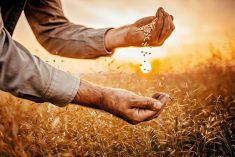Greg Mason, managing partner of Prairie Research Associates and economics professor at the University of Manitoba, discusses ag support programs.
It never seems the right time to review farm policies. I am writing this review just after storms blew through Manitoba, drenching crops for the umpteenth time and creating further predictions of a bleak outlook for farmers.
Against this backdrop, the crop failure in Russia has sent wheat futures soaring. However, just when farmers on the Prairies should be positioned to take advantage of increased prices, nature subverts the best laid plans. The grain crop across much of the Prairies has already been compromised by spring rains that delayed seeding.
Read Also

Gene editing digs deeper space in Canadian plant breeding
More Canadian research into crop variety development is incorporating gene editing, and one researcher notes that Canada’s regulatory approach to gene editing will help drive innovation
Even in the midst of apparent calamity, some producers are doing just fine, thank you very much. Farm journalism, like all journalism, is afflicted with attention deficit disorder, focusing on the extremes and usually the negative examples. It can be challenging to gain a centred and grounded view of the sector.
From a business operations perspective, farm businesses have added to net worth and steadily maintained their operating ratios of short-term assets to short-term liabilities.
Judged as a total business, even through the dire years of the BSE embargo, droughts and avian flu scare, the fact is that while some sectors and producers face periodic hardships, the agricultural sector in Canada continues to advance.
Based on Statistics Canada data, the typical farm in Canada is a business worth $1.3 million. Between 2004 and 2008, the proportion of off-farm income to total income has declined to 50 percent from 62 percent and the proportion of government support to total income has declined to 21 percent from 56 percent. This shows real progress toward sustainability in the sector.
Advances have occurred in canola, lentils, peas and soybeans. Livestock poses challenges but beef continues to consolidate and work toward a more secure financial foundation as the last vestiges of the BSE insanity work through the system.
Chinese economic growth and the associated insatiable demand for high quality meat is a promising context for the future of the beef industry. As for hogs, the current trouble arises from irrational exuberance and overinvestment as much as trade restrictions from the U.S., which are an ever-present irritant for all industries in Canada.
Throughout the weather-induced price gyrations, government plays a continuing role. Any setback is usually greeted with calls from industry leaders and individual farmers for immediate government relief.
Recent evolution in farm policy will challenge farmers to respond with revised business planning.
In the late 1970s through the 1990s, government responded to each farm “crisis” with ad hoc cash payments, but this started to change in the last 10 years. The increasing level of payments were seen by federal and provincial governments correctly as a form of income support or social welfare and not the partnership needed to support business.
The new model emerged with the Agricultural Policy Framework in 2003, which started to orient public support toward sustainable business models and not as a tool to support the family farm or rural ways of life.
Growing Forward, the current incarnation, continues the emphasis on building a “competitive and innovative sector,” increasing food safety and environmental responsibility, and implementing a “proactive approach to risk management.”
Another important aspect of public policy toward agriculture in Canada is the increasing role of provincial and territorial governments in delivering programs .
Producers can expect these trends to continue. One possible direction is the merging of AgriInsurance and AgriStability as the individual producer assumes increasing responsibility for managing transient impacts of weather, either by purchasing private insurance or adopting other strategies such as diversification in land holdings.
The core logic of the now amended Canadian Agricultural Income Stabilization program (CAIS) is sound and will likely continue through the next generation of Growing Forward.
Producers receive payments under AgriStability based on having some positive historic margins, an approach that supports producers experiencing temporary losses but disqualifying those unable to recover profitability.
The concept of a proactive approach to risk management means increasing onus on the business owner to manage transitory risks privately, using the government program as a platform for long-term investment.
Producers can expect this model to continue as farms are increasingly seen as business operations and agricultural policy begins to resemble industrial policy.
One area where government, especially the federal government, will continue to play a lead role is in managing the geopolitical environment. The BSE embargo is the best recent example, where a relatively minor animal health issue was manipulated by narrow local interests in the United States to become a major crisis for Canadian beef producers.
In such cases, the federal government must act internally to support the industry financially and externally to defend our trade interests.
Designing a robust farm policy confronts many challenges, but the basic job is to focus on the long-term trends. This is very hard to do.
It has just started to rain again.














